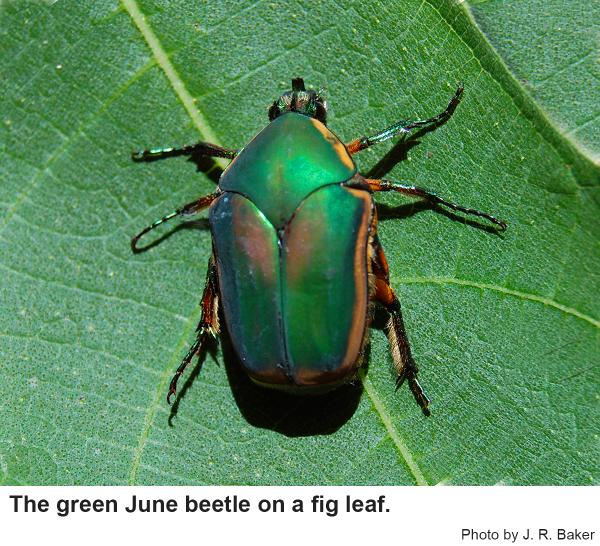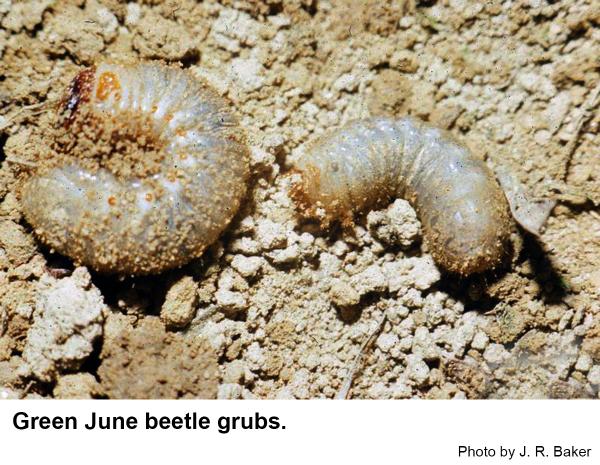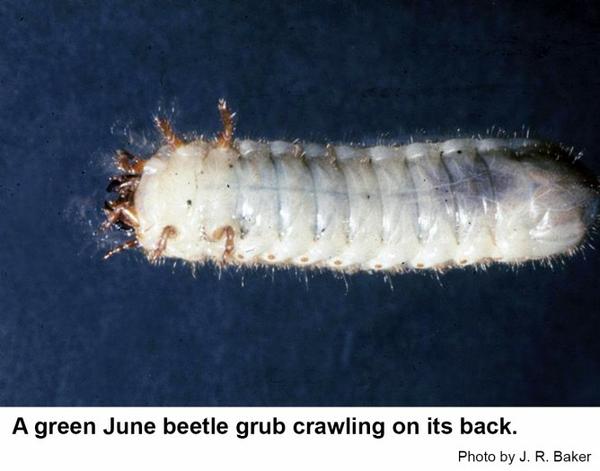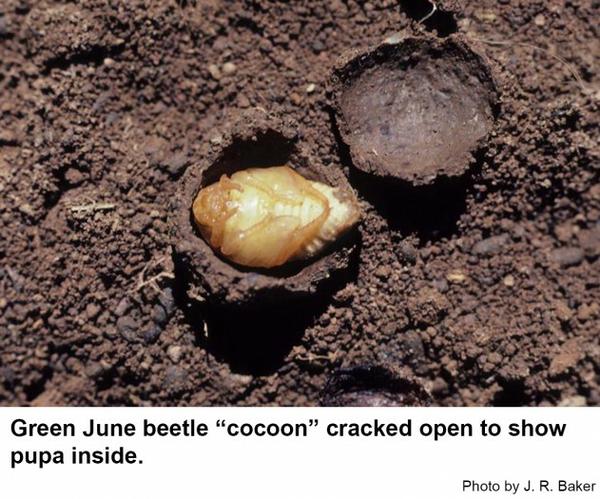Description and Biology
Adult green June beetles, Cotinus nitida, are metallic green and nearly 1 inch long. The body margins are bronze to yellow and wing covers are sometimes reddish brown. Pupae are brown and 1/2 inch long, and grubs are cream-colored and grow from 1/4 inch to 2 inches long. Grubs often hunch across the ground on their backs while extending their legs upward. Eggs are round, about 1/16 inch in diameter, and are laid in walnut-sized clusters of 10 to 30. Third-instar green June beetle grubs produce a secretion that binds soil particles together and enables them to form a protective case in which they overwinter in the soil. By May, larvae begin to pupate, and adults develop within 2 to 3 weeks. They emerge to mate in July and August, becoming most abundant around the time that early-maturing apples are harvested. Mated females lay eggs in debris, showing a preference for moist organic soil. Eggs hatch in 10 to 15 days. Larvae feed on rotting organic material and other less fortunate insects until reaching the third, overwintering stage. We have one generation per year in North Carolina. Green June beetles are commonly seen flying near the ground in landscapes from mid to late summer. They occasionally becoming pests of fruit, especially figs. Green June beetle grubs are large and are edible. Homeowners sometimes find hundreds or thousands of these large, white grubs on the sidewalks and driveways around the house.
Host Plants
Green June beetles feed as chafers on the foliage and fruit of trees in mid summer. Foliage may be skeletonized until there is no leaf tissue remaining between the veins. Damage appears similar to that of Japanese beetles. Adults chew irregular holes in fruit, sometimes to the point fruit is almost entirely consumed. In some regions these beetles are called "fig-eaters." In turf, the grubs sometimes keep a tunnel open to the soil surface and push up small mounds, or turrets of loose soil that resemble earthworm castings. Tunneling by the grubs and burrowing by the adults can cause even more damage by uprooting young grass seedlings. It is reported that green June beetle grubs feed on decaying organic matter in the thatch and root zone of many grasses, as well as on the underground portions of other plants such as sweet potatoes and carrots. The author kept a green June beetle grub that ate 12 Japanese beetle grubs and one and a half black cutworms within a week before it pupated, so the grubs may have some beneficial impact as well.
Residential Recommendation
If there is no indication of turf damage due to tunneling by the grubs, no action is really necessary. Green June beetles are most common in older lawns and pastures with high organic content soils or manure fertilizers. Green June beetle grubs are unusual also in that they are susceptible to Sevin insecticide applied as a dust or spray to the surface of the soil of infested turf (other white grubs are not). The Sevin shouldn't be watered in. Sevin does not get down into the soil to kill the grubs, rather the grubs come up to the surface and come in contact with the Sevin residue. Late summer is a good time to treat while grubs are small and still close to the surface of the soil. The only complaint about using Sevin for green June beetle control is that with large numbers of grubs, the dead grubs produce a bad odor as they decay. Sevin can also be used to protect the foliage of plants attcked by adults. Adult green June beetles are strong fliers and often appear suddenly; therefore, protecting fruit and foliage requires some diligence.
References
- Green June Beetle. Anonymous. © 2023. OSU Extension, Oklahoma State University.
- Green June beetle. Univ. Arkansas Arthropod Museum. Barnes, J. K. 2006. Dept. Entomology. Univ. Arkansas Div. of Agr. Coop. Ext. Service. Arkansas Arthropods No. 41.
- White Grubs in Turf. Brandenburg, R. L and T. Billeisen. 2017 (revised). TurfFiles
Publication date: Jan. 29, 2013
Revised: May 6, 2023
Recommendations for the use of agricultural chemicals are included in this publication as a convenience to the reader. The use of brand names and any mention or listing of commercial products or services in this publication does not imply endorsement by NC State University or N.C. A&T State University nor discrimination against similar products or services not mentioned. Individuals who use agricultural chemicals are responsible for ensuring that the intended use complies with current regulations and conforms to the product label. Be sure to obtain current information about usage regulations and examine a current product label before applying any chemical. For assistance, contact your local N.C. Cooperative Extension county center.
N.C. Cooperative Extension prohibits discrimination and harassment regardless of age, color, disability, family and marital status, gender identity, national origin, political beliefs, race, religion, sex (including pregnancy), sexual orientation and veteran status.





